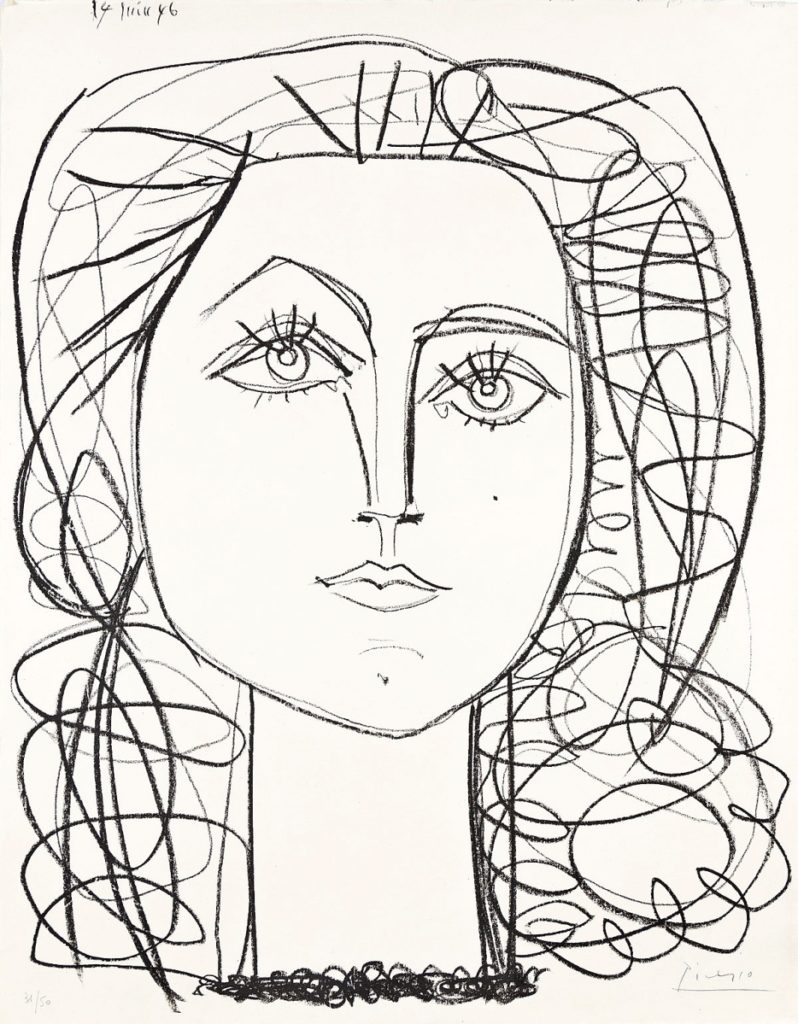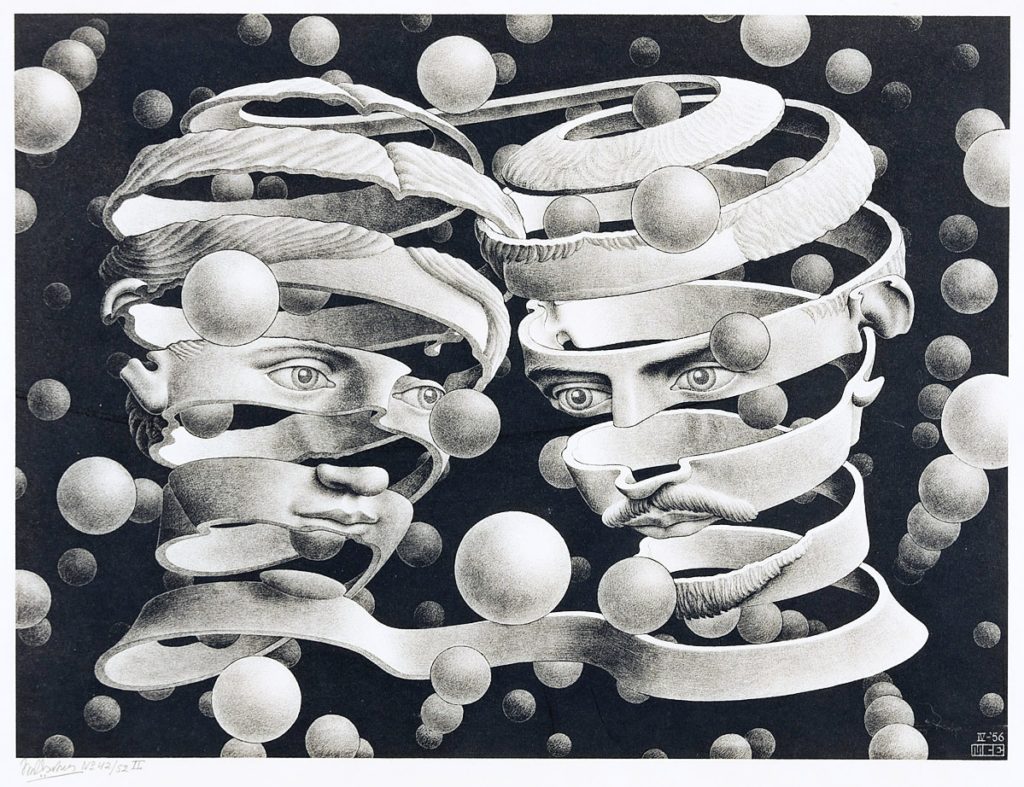
The top lot at $87,500 was Pablo Picasso’s (1881-1973) important lithograph, “Françoise,” 1946, signed and numbered 31/50 in pencil on the lower margin and measuring 25¼ by 19-5/8 inches.
Review by W.A. Demers, Photos Courtesy Swann Auction Galleries
NEW YORK CITY – Swann Galleries assembled a sale of Old Master through Modern prints from several private collections, offering a selection of 482 lots on November 3. The sale total was $2,533,450, of the 482 lots offered, 344 sold for a 71 percent sell-through rate, with 431 registered buyers.
The top lot at $87,500 was Pablo Picasso’s (1881-1973) important lithograph, “Françoise,” 1946, signed and numbered 31/50 in pencil on the lower margin and measuring 25¼ by 19-5/8 inches. In this lithograph, from a series of 11 different versions Picasso made during June 1946, Picasso shows Françoise Gilot (b 1921) with characteristic narrow, arching eyebrows, full lips and youthful visage. Picasso called her his muse and mistress from 1943 to 1953 and the mother of their children, Claude and Paloma. Françoise was born to a wealthy family in Neuilly-sur-Seine, her father was a businessman, and her mother was an amateur artist. From an early age, Françoise yearned to be an artist like her mother, but her father forced her into studying law, which she ultimately abandoned after several failed attempts to resist her father’s control, by 1942 devoting her life to becoming an artist. Among Picasso’s many lovers, she became “The Woman Who Says No,” defying him and ultimately leaving him in the south of France.
Trippy lithographs from the Dutch master of sense-defying illustrations, Maurits C. (M.C.) Escher (1898-1972) performed strongly in this sale, with his “Relativity,” 1953, defying its own $40/60,000 estimate to realize $81,250. Characterized as “a superb impression of this extremely scarce lithograph,” the 11-by-11½-inch piece, signed and numbered “No. 2/20” in pencil, lower left, was said to be one of only eight other impressions that have crossed the auction block in the past 30 years. The “relativity” that Escher addresses in this image is one’s perception of the world and the laws of gravity as we know them. Catalog notes quote Escher expert F. Wierda Bool saying, “The architectural structure seems to be the center of an idyllic community, with most of its inhabitants casually going about their ordinary business, such as dining. There are windows and doorways leading to park-like outdoor settings. All of the figures are dressed in identical attire and have featureless bulb-shaped heads. In the world of Relativity, there are three sources of gravity, each being orthogonal to the two others. Each inhabitant lives in one of the gravity wells, where normal physical laws apply. There are 16 characters, spread between each gravity source, six in one and five each in the other two. The apparent confusion of the lithograph comes from the fact that the three gravity sources are depicted in the same space.”
Similarly, in Escher’s “Bond of Union,” the sale’s cover graphic, the real-life heads of Escher and his wife Jetta are represented and broken up into one connected strap. The two heads hover in the void, surrounded by floating bubble-like globes. One of the rare portraits Escher made after World War II, the 1956 lithograph, 10 by 13-3/8 inches, signed and numbered “No. 42/52 II” in pencil, lower left, went out at $68,750, more than twice its high estimate. Escher, in a 1968 interview, said he was experimenting with “the concept of endlessness and a reaction to sculpture.”

The sale’s cover lot, Escher’s “Bond of Union,” depicted the real-life heads of Escher and his wife Jetta, which were represented as broken up into one connected strap, their heads hovering in the void, surrounded by floating, bubble-like globes. One of the rare portraits Escher made after World War II, the 1956 lithograph, 10 by 13-3/8 inches, signed and numbered “No. 42/52 II” in pencil, lower left, went out at $68,750, more than twice its high estimate.
Escher’s “Belvedere,” 1958, and “Print Gallery,” 1956, also did well, pulling in $57,500 and $55,000, respectively.
By Dutch Golden Age painter, printmaker and draughtsman Rembrandt Van Rijn (1606-1669), an Old Master highlight was “Christ Receiving the Children and Healing the Sick” (The Hundred Guilder Print), an etching, engraving and drypoint, circa 1648. Depicted in the atmospheric scene is a woman holding a baby before Christ’s outstretched right arm, a seated woman and kneeling figure with back turned at Christ’s feet and other figures to the right of Christ. The 11-1/8-by-15¼-inch impression was bid to $72,500.
Also by Rembrandt and fetching $50,000 was the artist’s “Self Portrait with Plumed Cap and Lowered Sabre,” an oval etching and engraving from 1634, which measured 5¼ by 4¼ inches.
Another Old Master heavy-hitter Albrecht Dürer (German, 1471-1528) was represented by “Melencolia I,” a contemplative engraving from 1514 in which the painter, printmaker and theorist of the German Renaissance complemented “St. Jerome in his Study” and “Knight, Death and the Devil,” also from 1514, with a richly symbolic depiction of an enigmatic and gloomy winged female figure thought to be a personification of melancholy, holding her head in her hand, she stares past the busy scene in front of her. The 9½-by-7½-inch engraving took $55,000.

Maurits C. (M.C.) Escher’s (1898-1972) “Relativity,” 1953, defied both the senses and its own $40/60,000 estimate to realize $81,250. The 11-by-11½-inch piece, signed and numbered “No. 2/20” in pencil, lower left, was said to be one of only eight other impressions that have crossed the auction block in the past 30 years.
American realist painter and printmaker Edward Hopper (1882-1967) was among the highlights, of course, with his 1921 etching “Night Shadows” leaving the gallery at $47,500. Widely known for his oil paintings, he was equally proficient as a watercolorist and printmaker in etching, creating subdued drama out of commonplace subjects, using a bird’s-eye vantage point with extended shadows and darkness to intensify the suspense and drama and leaving the viewer to interpret the story. At 7 by 8¼ inches with full margins, this one was edition of approximately 500. It was signed in pencil lower right and published by The New Republic, New York.
A color lithograph after Marc Chagall (Jewish-French, 1887-1985), “Romeo and Juliet,” 1964, sold for $40,000. Chagall’s exceptional career as a lithographer was greatly facilitated by his ongoing artistic collaboration with the master-printer Charles Sorlier of the Atelier Mourlot, Paris. Though Chagall made lithographs as early as the 1920s, his lithographic work blossomed from the 1950s onward, under the guidance of Sorlier. Sorlier became so familiar with Chagall’s work (and Chagall relied on Sorlier’s judgment to such an extent) that Sorlier created a number of prints in a style “after” Chagall, as interpretive designs of Chagall’s original paintings and gouaches.
Prices given include the buyer’s premium as stated by the auction house. For information, www.swanngalleries.com or 212-254-4710.












